The Air-Sea Nitrous Oxide Flux along Cruise Tracks to the Arctic Ocean and Southern Ocean
Abstract
:1. Introduction
2. Methods and Study Region
2.1. Study Area and Other Data
2.2. Analytical Methods
2.3. Calculation of Saturation Anomaly and Air-Sea Flux
3. Results and Discussion
3.1. Distribution of N2O in the Surface Waters along the CHINARE Cruise Track
3.2. Saturation Anomalies of Different Regions and Their Regulatory Factors
3.2.1. Tropical and Subtropical Seas
3.2.2. Subpolar Oceans
3.2.3. Polar Oceans
3.3. Air-Sea Fluxes
4. Conclusions
Acknowledgments
Author Contributions
Conflicts of Interest
References
- Khalil, M.A.K.; Rasmussen, R.A.; Shearer, M.J. Atmospheric nitrous oxide: Patterns of global change during recent decades and centuries. Chemosphere 2002, 47, 807–821. [Google Scholar] [CrossRef]
- Clark, D.; Brown, I.; Rees, A.; Somerfield, P.; Miller, P. The influence of ocean acidification on nitrogen regeneration and nitrous oxide production in the North-West European shelf sea. Biogeosci. Discuss. 2014, 11, 3113–3165. [Google Scholar] [CrossRef]
- Ravishankara, A.R.; Daniel, J.S.; Portmann, R.W. Nitrous oxide (N2O): The dominant ozone-depleting substance emitted in the 21st century. Science 2009, 326, 123. [Google Scholar] [CrossRef] [PubMed]
- Nevison, C.D.; Weiss, R.F.; Erickson, D.J. Global oceanic emissions of nitrous oxide. J. Geophys. Res. 1995, 100, 15809–15820. [Google Scholar] [CrossRef]
- Suntharalingam, P.; Sarmiento, J.L. Factors governing the oceanic nitrous oxide distribution: Simulations with an ocean general circulation model. Glob. Biogeochem. Cycles 2000, 14, 429–454. [Google Scholar] [CrossRef]
- Freing, A.; Wallace, D.W.; Bange, H.W. Global oceanic production of nitrous oxide. Philos. Trans. R. Soc. Lond. B Biol. Sci. 2012, 367, 1245–1255. [Google Scholar] [CrossRef] [PubMed] [Green Version]
- Arevalo-Martinez, D.L.; Kock, A.; Loscher, C.R.; Schmitz, R.A.; Bange, H.W. Massive nitrous oxide emissions from the tropical South Pacific Ocean. Nat. Geosci. 2015, 8, 530–533. [Google Scholar] [CrossRef]
- Bange, H.W.; Rapsomanikis, S.; Andreae, M.O. Nitrous oxide emissions from the Arabian Sea. Geophys. Res. Lett. 1996, 23, 3175–3178. [Google Scholar] [CrossRef] [Green Version]
- Bouwman, A.F.; Van der Hoek, K.W.; Olivier, J.G.J. Uncertainties in the global source distribution of nitrous oxide. J. Geophys. Res. 1995, 100, 2785–2800. [Google Scholar] [CrossRef]
- Nevison, C.D.; Keeling, R.F.; Weiss, R.F.; Popp, B.N.; Jin, X.; Fraser, P.J.; Porter, L.W.; Hess, P.G. Southern ocean ventilation inferred from seasonal cycles of atmospheric N2O and O2/N2 at Cape Grim, Tasmania. Tellus B 2005, 57, 218–229. [Google Scholar] [CrossRef]
- Huang, J.; Golombek, A.; Prinn, R.; Weiss, R.; Fraser, P.; Simmonds, P.; Dlugokencky, E.J.; Hall, B.; Elkins, J.; Steele, P. Estimation of regional emissions of nitrous oxide from 1997 to 2005 using multinetwork measurements, a chemical transport model, and an inverse method. J. Geophys. Res. 2008, 113, D17313. [Google Scholar] [CrossRef]
- Hirsch, A.I.; Michalak, A.M.; Bruhwiler, L.M.; Peters, W.; Dlugokencky, E.J.; Tans, P.P. Inverse modeling estimates of the global nitrous oxide surface flux from 1998–2001. Glob. Biogeochem. Cycles 2006, 20. [Google Scholar] [CrossRef]
- Rees, A.P.; Owens, N.J.P.; Upstill-Goddard, R.C. Nitrous oxide in the Bellingshausen sea and drake passage. J. Geophys. Res. 1997, 102, 3383–3392. [Google Scholar] [CrossRef]
- Zhan, L.; Chen, L.; Zhang, J.; Yan, J.; Li, Y.; Wu, M.; Xu, S.; Lin, Q.; Pan, J.; Zhao, J. Austral summer N2O sink and source characteristics and their impact factors in Prydz Bay, Antarctica. J. Geophys. Res. Oceans 2015, 120, 5836–5849. [Google Scholar] [CrossRef]
- Kitidis, V.; Upstill-Goddard, R.C.; Anderson, L.G. Methane and nitrous oxide in surface water along the North-West passage, Arctic Ocean. Mar. Chem. 2010, 121, 80–86. [Google Scholar] [CrossRef]
- Hirota, A.; Ijiri, A.; Komatsu, D.D.; Ohkubo, S.B.; Nakagawa, F.; Tsunogai, U. Enrichment of nitrous oxide in the water columns in the area of the Bering and Chukchi seas. Mar. Chem. 2009, 116, 47–53. [Google Scholar] [CrossRef]
- Zhang, J.; Zhan, L.; Chen, L.; Li, Y.; Chen, J. Coexistence of nitrous oxide undersaturation and oversaturation in the surface and subsurface of the western Arctic Ocean. J. Geophys. Res. Oceans 2015. [Google Scholar] [CrossRef]
- Butler, J.H.; Elkins, J.W. An automated technique for the measurement of dissolved N2O in natural waters. Mar. Chem. 1991, 34, 47–61. [Google Scholar] [CrossRef]
- Bange, H.W.; Rapsomanikis, S.; Andreae, M.O. Nitrous oxide in coastal waters. Glob. Biogeochem. Cycles 1996, 10, 197–207. [Google Scholar] [CrossRef] [Green Version]
- Cohen, Y. Shipboard measurement of dissolved nitrous oxide in sea water by electron capture gas chromatography. Anal. Chem. 1977, 49, 1238–1240. [Google Scholar] [CrossRef]
- Capelle, D.W.; Dacey, J.W.; Tortell, P.D. An automated, high through-put method for accurate and precise measurements of dissolved nitrous-oxide and methane concentrations in natural waters. Limnol. Oceanogr. Methods 2015, 13, 345–355. [Google Scholar] [CrossRef]
- Zhan, L.Y.; Chen, L.Q.; Zhang, J.X.; Lin, Q. A system for the automated static headspace analysis of dissolved N2O in seawater. Int. J. Environ. Anal. Chem. 2012, 93, 828–842. [Google Scholar] [CrossRef]
- Weiss, R.F.; Price, B.A. Nitrous oxide solubility in water and seawater. Mar. Chem. 1980, 8, 347–359. [Google Scholar] [CrossRef]
- Combined Nitrous Oxide Data from the NOAA/ESRL Global Monitoring Division. Available online: www.esrl.noaa.gov/gmd/hats (accessed on 15 July 2017).
- Jiang, L.Q.; Cai, W.J.; Wanninkhof, R.; Wang, Y.; Luger, H. Air-sea CO2 fluxes on the US South Atlantic Bight: Spatial and seasonal variability. J. Geophys. Res. Oceans 2008, 113, C07019. [Google Scholar] [CrossRef]
- Wanninkhof, R. Relationship between wind speed and gas exchange. J. Geophys. Res. 1992, 97, 7373–7382. [Google Scholar] [CrossRef]
- Wanninkhof, R. Relationship between wind speed and gas exchange over the ocean revisited. Limnol. Oceanogr. Methods 2014, 12, 351–362. [Google Scholar] [CrossRef]
- Zhan, L.; Chen, L. Distributions of N2O and its air-sea fluxes in seawater along cruise tracks between 30° S–67° S and in Prydz Bay, Antarctica. J. Geophys. Res. 2009, 114, C03019. [Google Scholar] [CrossRef]
- Butler, J.; Elkins, J.; Brunson, C.; Egan, K.; Thompson, T.; Conway, T.; Hall, B. Trace Gases in and over the West Pacific and East Indian Oceans during the El Niño-Southern Oscillation Event of 1987. Available online: http://adsabs.harvard.edu/abs/1988saga.rept.....B (accessed on 15 July 2017).
- Walter, S.; Bange, H.W.; Wallace, D.W.R. Nitrous oxide in the surface layer of the tropical North Atlantic Ocean along a west to east transect. Geophys. Res. Lett. 2004, 31, L23S07. [Google Scholar] [CrossRef]
- Butler, J.; Elkins, J.; Thompson, T.; Egan, K. Tropospheric and dissolved N2O of the west Pacific and east Indian Oceans during the El Niño Southern Oscillation event of 1987. J. Geophys. Res. 1989, 94, 14865–14877. [Google Scholar] [CrossRef]
- Asia-Pacific Data-Research Cneter of the IPRC. Available online: http://apdrc.soest.hawaii.edu/data/data.phphttp://apdrc.soest.hawaii.edu/data/data.php (accessed on 15 July 2017).
- Tomczak, M.; Godfrey, J.S. Regional Oceanography: An Introduction, 1st ed.; Elsevier Science Ltd.: New York, NY, USA, 1994. [Google Scholar]
- Wu, M.; Chen, L.; Zhan, L.; Zhang, J.; Li, Y.; Liu, J. Spatial Variability and Factors Influencing the Air-Sea N2O Flux in the Bering Sea, Chukchi Sea and Chukchi Abyssal Plain. Atmosphere 2017, 8, 65. [Google Scholar] [CrossRef]
- Randall, K.; Scarratt, M.; Levasseur, M.; Michaud, S.; Xie, H.; Gosselin, M. First measurements of nitrous oxide in Arctic sea ice. J. Geophys. Res. Oceans 2012, 117. [Google Scholar] [CrossRef]
- Li, Y.H.; Peng, T.H.; Broecker, W.S.; Oestlund, H. The average vertical mixing coefficient for the oceanic thermocline. Tellus B 1984, 36, 212–217. [Google Scholar] [CrossRef]
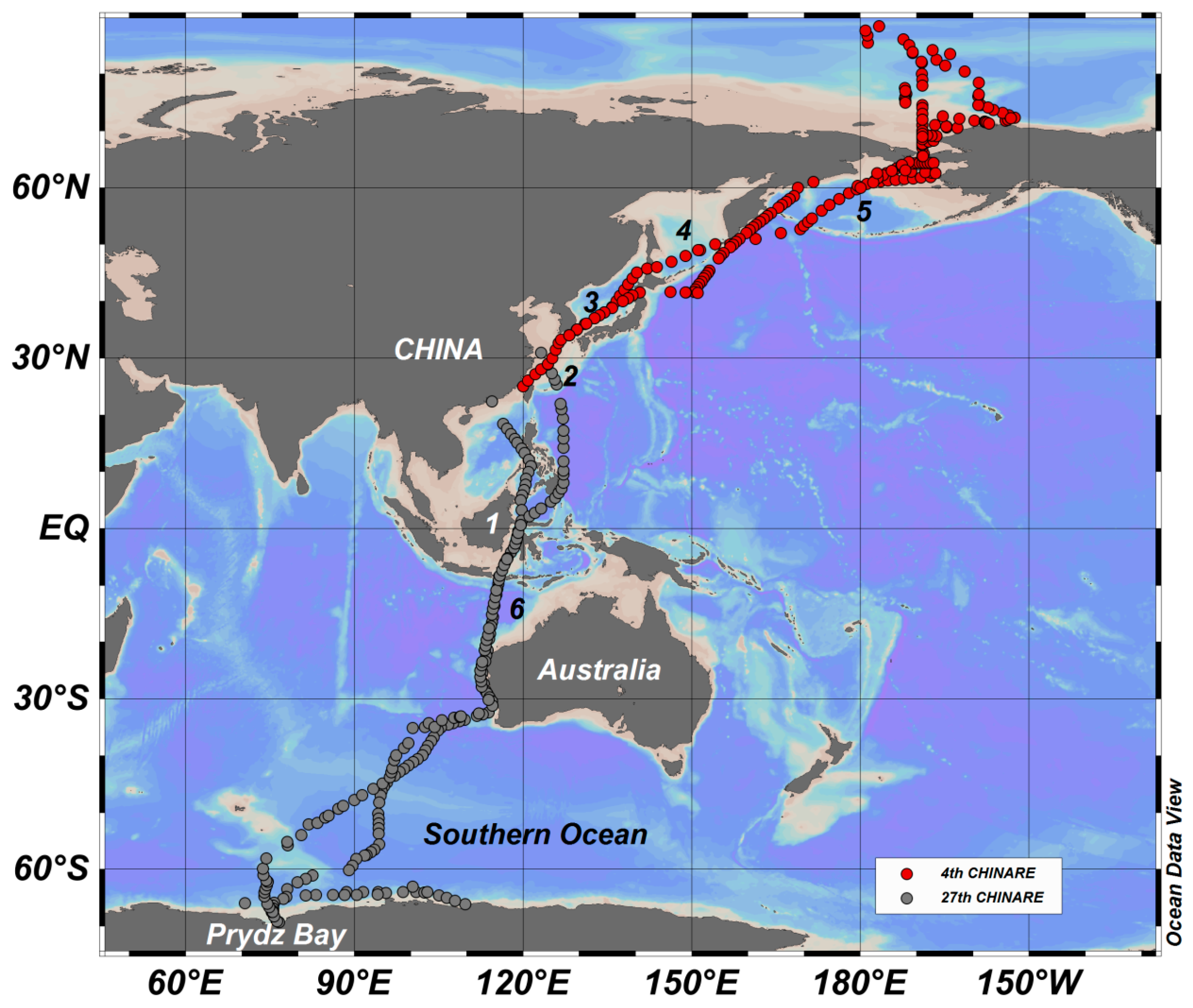
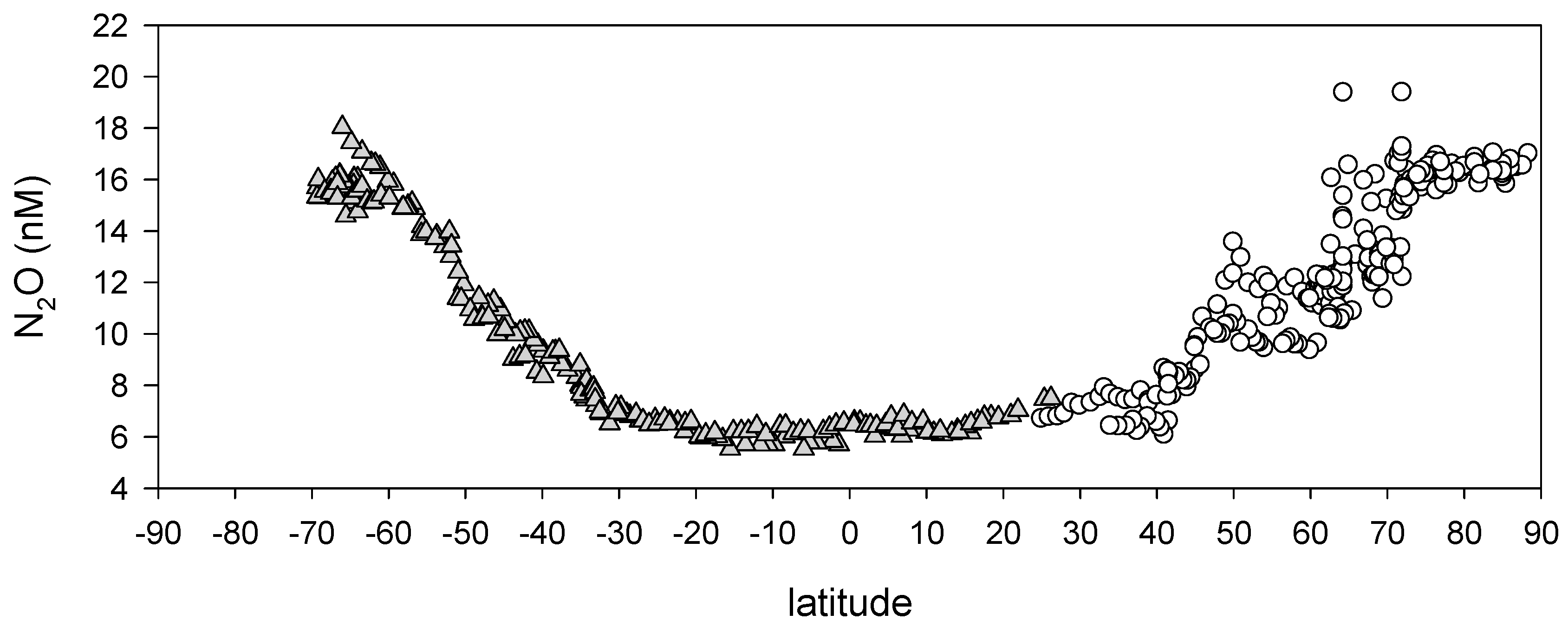
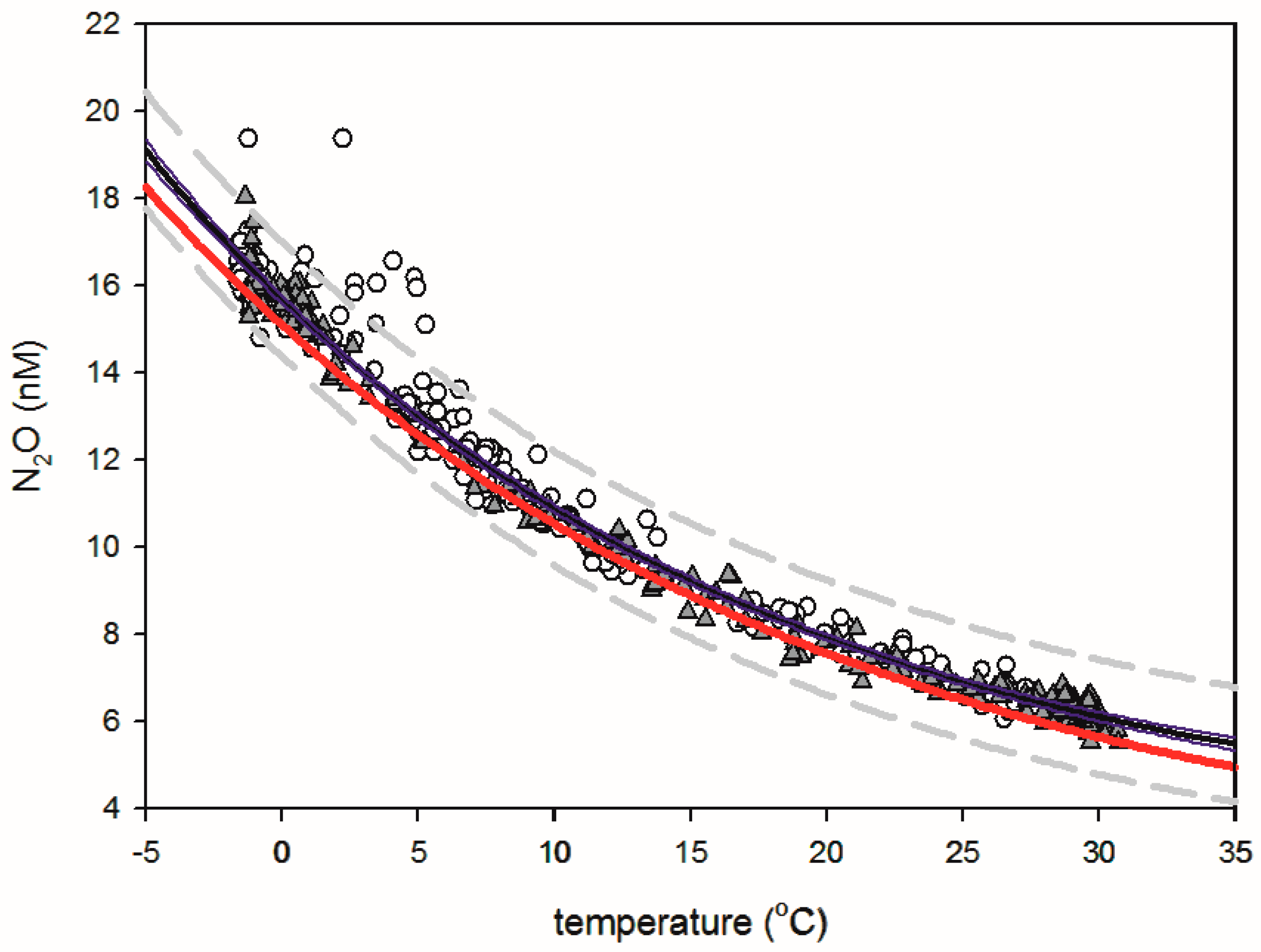
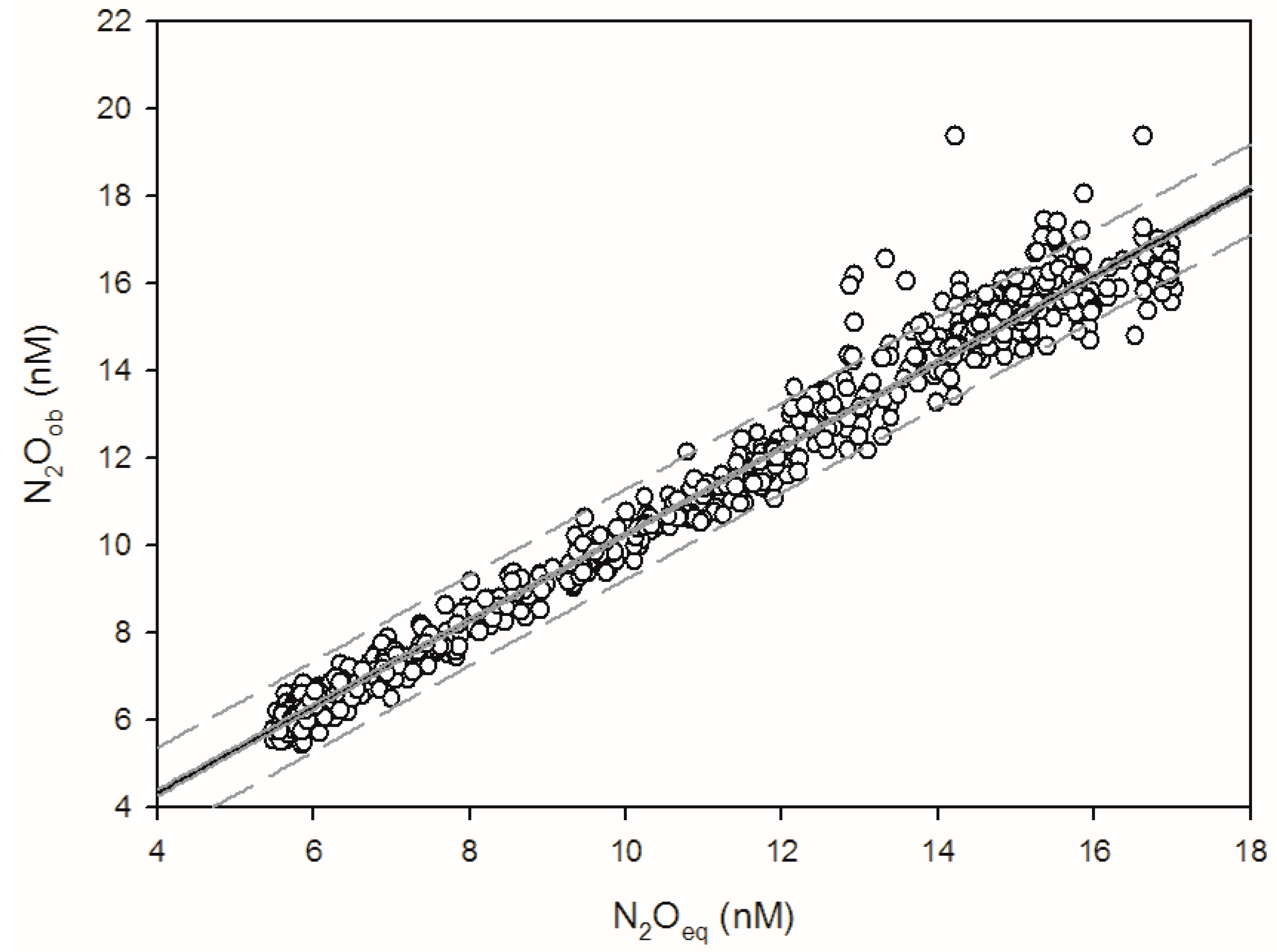
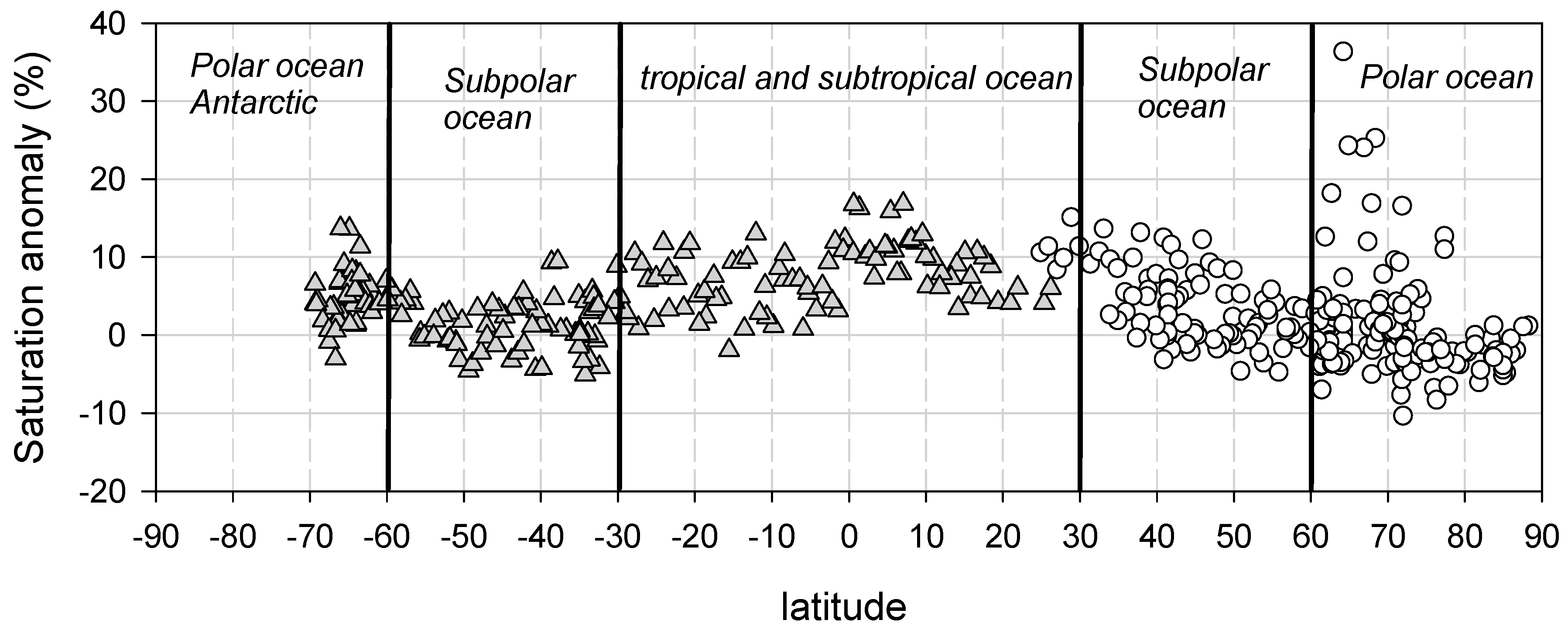
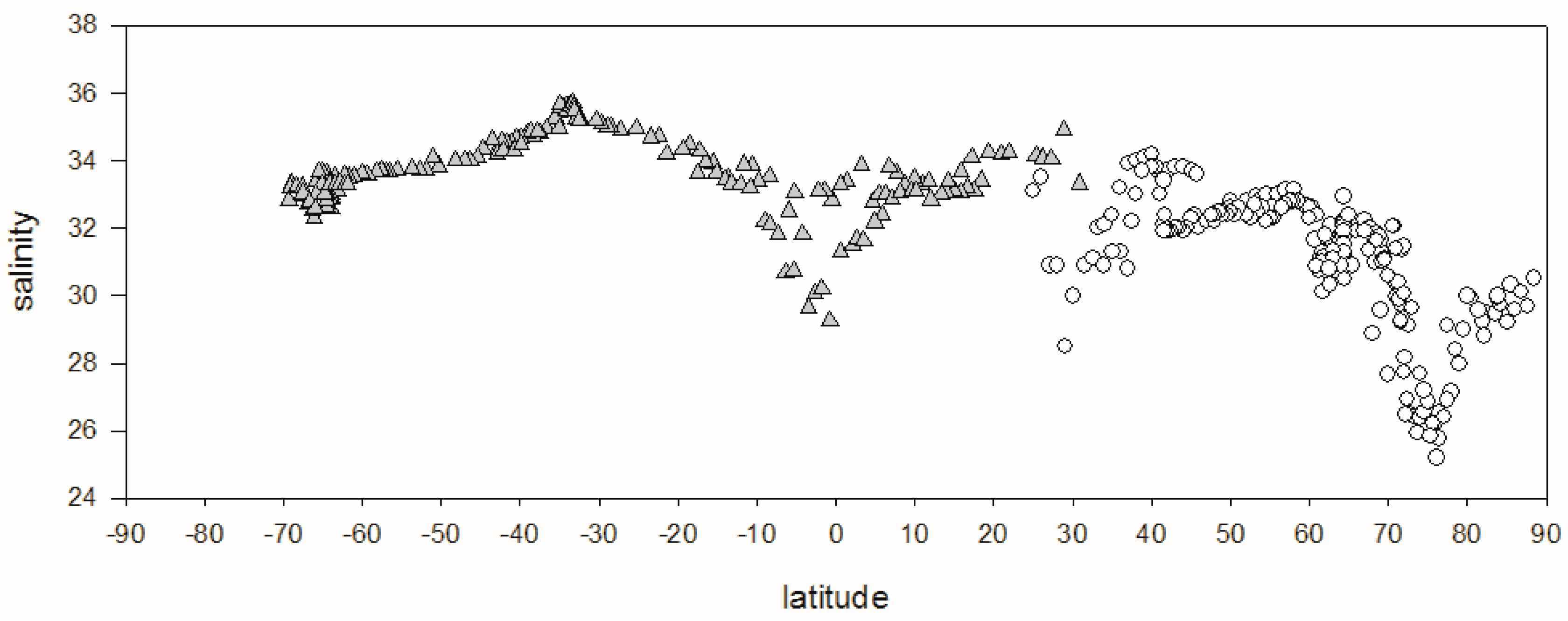
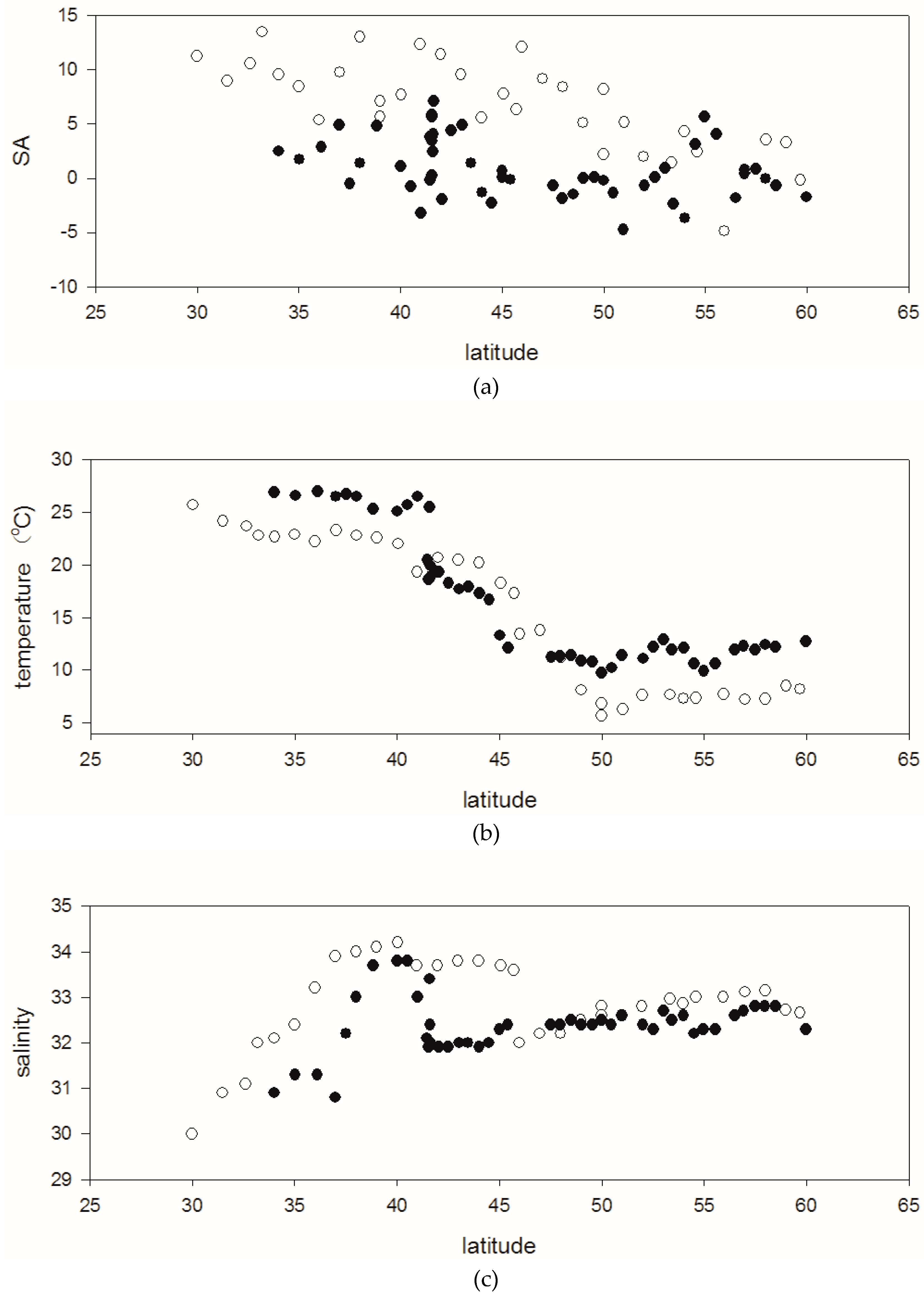

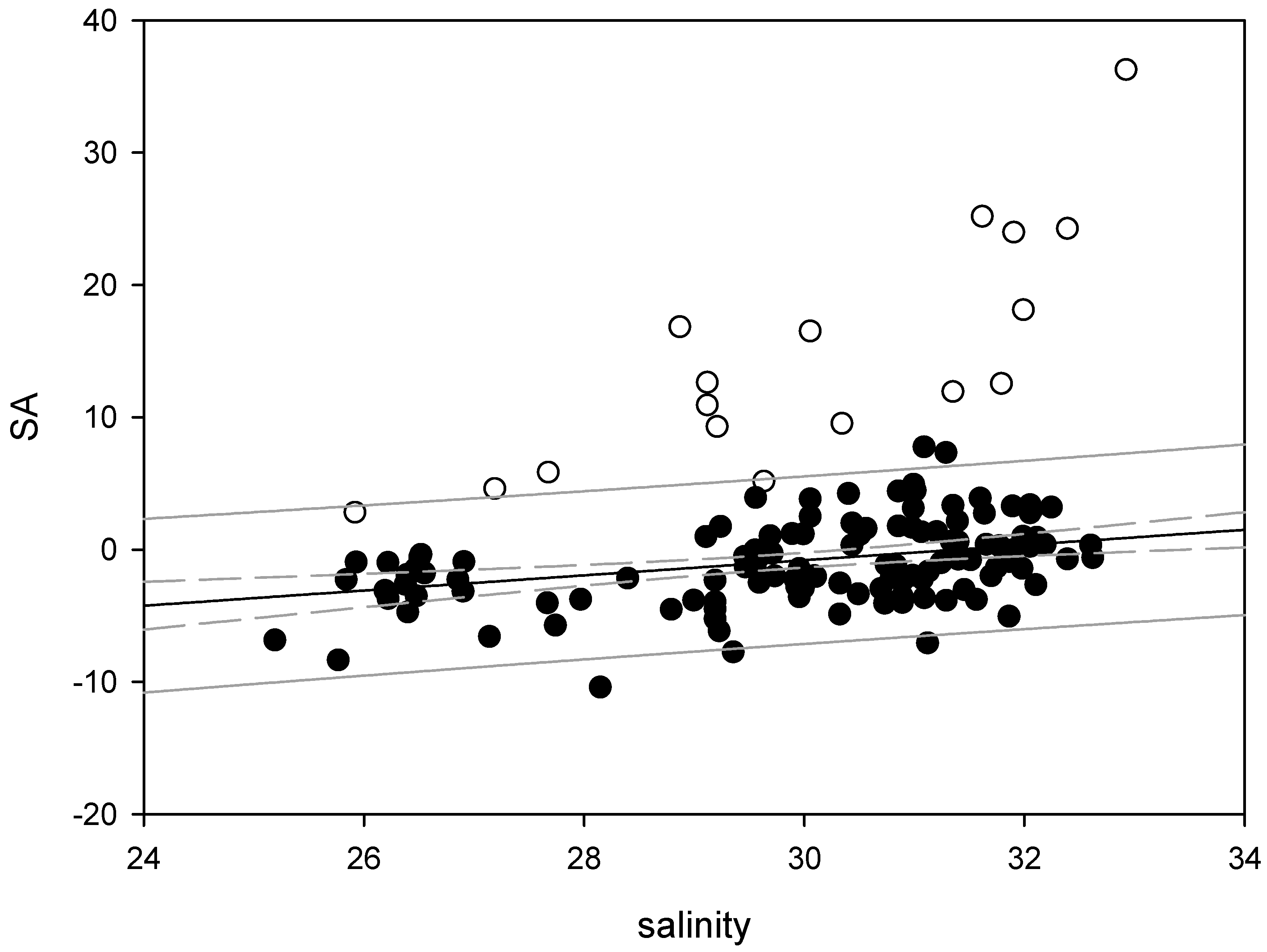
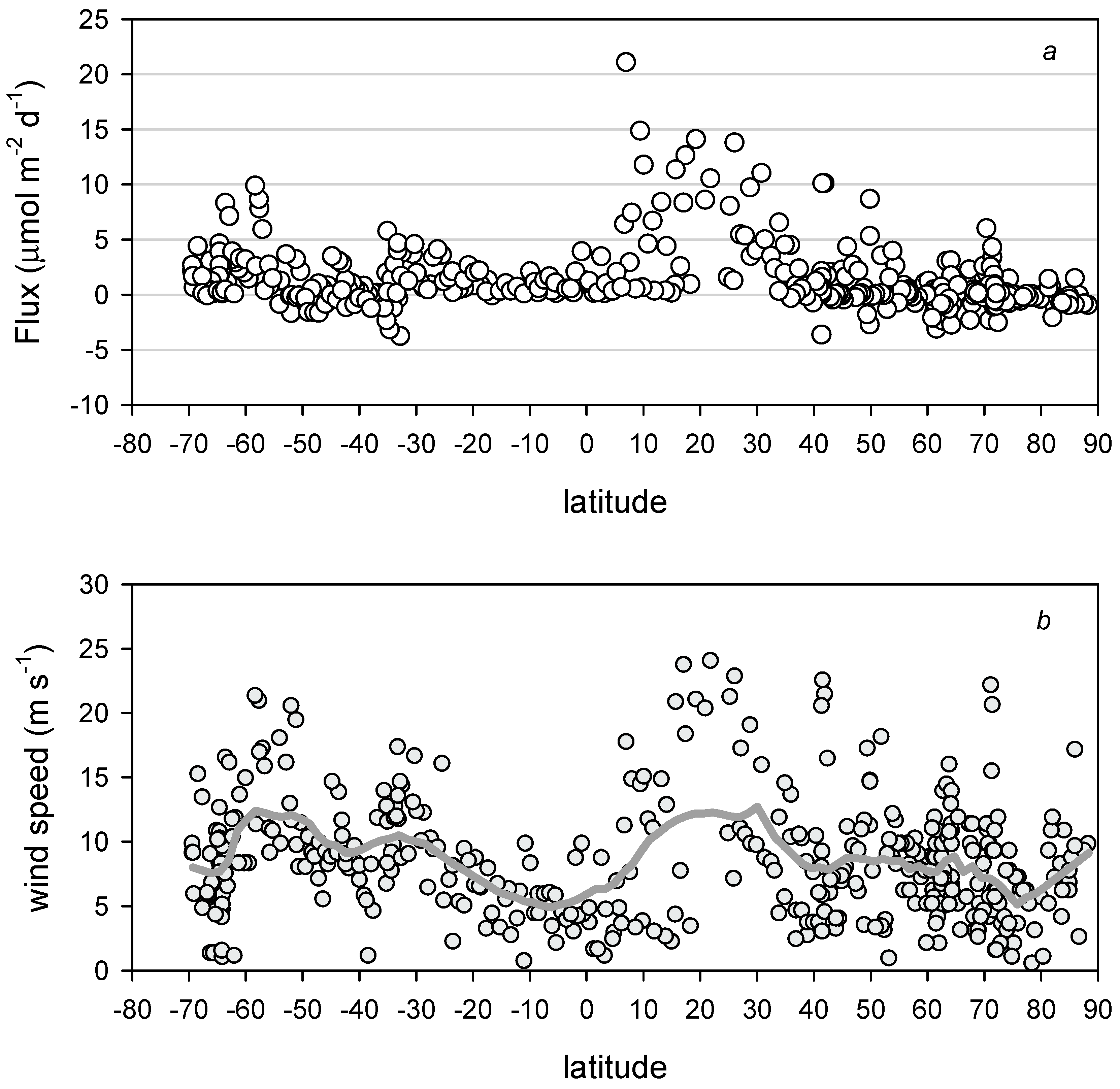
© 2017 by the authors. Licensee MDPI, Basel, Switzerland. This article is an open access article distributed under the terms and conditions of the Creative Commons Attribution (CC BY) license (http://creativecommons.org/licenses/by/4.0/).
Share and Cite
Zhan, L.; Wu, M.; Chen, L.; Zhang, J.; Li, Y.; Liu, J. The Air-Sea Nitrous Oxide Flux along Cruise Tracks to the Arctic Ocean and Southern Ocean. Atmosphere 2017, 8, 216. https://doi.org/10.3390/atmos8110216
Zhan L, Wu M, Chen L, Zhang J, Li Y, Liu J. The Air-Sea Nitrous Oxide Flux along Cruise Tracks to the Arctic Ocean and Southern Ocean. Atmosphere. 2017; 8(11):216. https://doi.org/10.3390/atmos8110216
Chicago/Turabian StyleZhan, Liyang, Man Wu, Liqi Chen, Jixia Zhang, Yuhong Li, and Jian Liu. 2017. "The Air-Sea Nitrous Oxide Flux along Cruise Tracks to the Arctic Ocean and Southern Ocean" Atmosphere 8, no. 11: 216. https://doi.org/10.3390/atmos8110216




